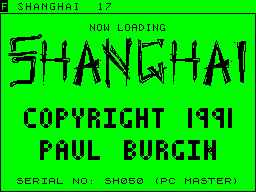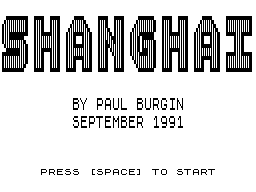Retro Replay Review
Gameplay
At its core, Shanghai faithfully recreates the classic solitaire mahjongg experience: your objective is to clear a single, prearranged layout of tiles by matching identical pairs. Only tiles with at least one free side (left or right) and no tiles on top are selectable, which transforms this seemingly simple pastime into a careful exercise in spatial reasoning. Every move you make can open new possibilities or trap you into a dead end, so planning ahead is essential.
Memorization plays a huge role here. With all tiles presented in monochrome, the design forces you to focus on shape and position rather than color hints. As you peel away layers, you’ll learn to recognize patterns and mentally map out sequences that maximize your chances of success. The lack of shortcuts—no “undo” button, no generous hint system—means each match must be considered deliberately.
Replayability hinges on the tension between a fixed layout and the scramble of available matches. Unlike other versions offering multiple boards or random patterns, this implementation includes only one static arrangement. That limitation can be a double-edged sword: once you’ve mastered the initial puzzle, repeat sessions become about shaving off time and mistakes, rather than discovering fresh configurations.
Graphics
Visually, Shanghai is unapologetically minimalist. The entire game is rendered in monochrome, harking back to early PC and DOS titles. Each tile’s intricate Chinese characters and symbols are composed of crisp, high-contrast pixels, making it easy to distinguish one design from another even without color.
This black-and-white presentation lends a nostalgic charm and keeps the interface uncluttered. There are no distracting backgrounds or flashy animations—just a stark playfield you can’t help but stare at as you hunt for edges, corners, and matching shapes. On modern screens, the tiles may look a bit austere, but they remain clear and readable at any resolution.
Because there’s so little in the way of graphical flourishes, performance is flawless on even the most modest hardware. You won’t encounter slowdowns, load times, or glitches—every click yields an immediate response. For purists who prize function over form, Shanghai’s visual style is perfectly suited to a no-nonsense puzzle session.
Story
Unlike narrative-driven adventure games, Shanghai offers no traditional story, characters, or cutscenes. There’s no overarching plot to follow, no motivational backstory. If you’re seeking drama or thematic context, you won’t find it here.
That absence of story is by design: all mental energy is channeled into the puzzle itself. You become the architect of your own experience, driven by the satisfaction of each successful match and the challenge of every near-stuck configuration. In this sense, the “story” is the unfolding dialogue between your problem-solving skills and the tiles on the board.
Some players may find this purity exhilarating, while others might miss atmospheric music or narrative hooks. But if you appreciate games that strip away all artifice and present a single, singular challenge, Shanghai’s bare-bones approach can feel oddly liberating.
Overall Experience
Shanghai stands as a testament to the enduring appeal of tile-matching puzzles. The game’s strict adherence to the classic rules—no extra layouts, no colorful assists—makes each victory feel genuinely earned. However, that same fidelity can lead to repetition once the one layout stops surprising you. Sessions become more about improving speed and efficiency than exploring new configurations.
Despite its simplicity, Shanghai excels at delivering a quietly addictive, contemplative experience. It’s perfect for short breaks when you want to test your focus or challenge a friend to beat your best time. Because you know exactly what to expect, it’s easy to slip into “just one more round” mode.
If you’re a fan of retro-style puzzle games or someone who enjoys a pure, uninterrupted brain-teaser, Shanghai remains a solid purchase. Just be prepared for its Spartan presentation and the realization that this lone layout is both its greatest strength and its most notable constraint. Ultimately, it offers a timeless challenge that rewards patience, memory, and careful planning. Good luck clearing the board!
 Retro Replay Retro Replay gaming reviews, news, emulation, geek stuff and more!
Retro Replay Retro Replay gaming reviews, news, emulation, geek stuff and more!








Reviews
There are no reviews yet.